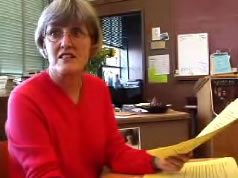 Clip
1: I was sorting the students into groups for
the discussions and was purposefully mixing the groups racially. Here I
am influenced by Troy Duster’s work at Cal years ago and his belief
in the importance of mixing students racially as learners. He felt the UC
system had an obligation to seek a racially mixed student body as a way
of breaking down stereotypes and a way of inviting everyone into the conversation.
It’s important to me that African Americans males particularly at
our school step up as students—take positions as thinkers, readers,
Clip
1: I was sorting the students into groups for
the discussions and was purposefully mixing the groups racially. Here I
am influenced by Troy Duster’s work at Cal years ago and his belief
in the importance of mixing students racially as learners. He felt the UC
system had an obligation to seek a racially mixed student body as a way
of breaking down stereotypes and a way of inviting everyone into the conversation.
It’s important to me that African Americans males particularly at
our school step up as students—take positions as thinkers, readers,
writers. I need to do what I can to bring them into academic conversations—for themselves (so they will learn how to do this kind of talk — see Guadalupe Valdez and Bahktin) and for their classmates.
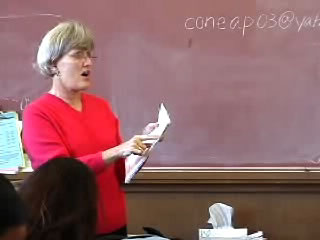 Clip
2: Something I became aware of as I watched this video is how much
my classroom reflects my life as a traveler—Tibet, Cambodia, Guatemala—and
my politics. I am not being disingenuous here: I am sure that people who
see this video or the parts that show my classroom may have some issues
with my blatant politicizing my classroom.
Clip
2: Something I became aware of as I watched this video is how much
my classroom reflects my life as a traveler—Tibet, Cambodia, Guatemala—and
my politics. I am not being disingenuous here: I am sure that people who
see this video or the parts that show my classroom may have some issues
with my blatant politicizing my classroom.
Introducing
the class: I almost always start the period by going over all
the things we have to do—to give kids the sense that we don’t
have a minute to waste. That’s big with me—and connects to
what Tim
Boerst said last summer. Teachers have to be purposeful in their lessons;
if we waste time we are disrespecting our students.
On testing: I do give tests on books. I hold them accountable
for assignments. The 90 minutes of writing on a book is my way of preparing
them for college exams but also I allow that much time because I want
them to spend time thinking deeply about the books they’ve read.
Which books? In this case it was non-fiction works they had chosen to
read in small literature circles. That’s why I had to make up individual
tests.
Analyzing text in groups: Influenced by Vygotsky, I see
talk as a tool for learning. So, to prepare kids for writing their “first
official AP text analysis essay” I had them get into groups, read
it, and discuss it as a prelude to writing it on their own two days later.
Here I am influenced by the Goodmans (Ken and Yetta) who also use talk
as a tool for learning but have this neat idea that instead of having
an expert other—the way Vygotsky talks about the Zone of Proximal
Development (ZPD), they believe that kids talking in a small group create
their own sense of expert other; that is, working together, kids in a
group create a real sense of expertise over a piece of text. This was
not the first time I had given these kids a piece of text analysis. We
worked out a few in class. But this was the first AP prompt and passage
they had done.
Diving students into groups and explaining the task:
Before moving kids into groups, I give them clear directions about
what they are going to do in the group. If I do this beforehand, I don’t
have to go around to each group and check that they know what they’re
doing.
How I choose leaders: I change them constantly because
I want all kids to get a chance to lead.
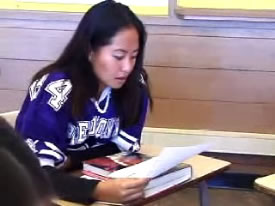 Clip
3:
Christine takes the lead—she is a student leader and a good reader.
I think it’s important to show this part—how one student reads
through it, they attempt a little discussion, and they someone says, “let’s
read it again.” I didn’t tell them they had to do that but it
is something we do all the time in class. Get a quick interpretation, and
then go back to reread to get a deeper one. Notice Christine calls on Josh
to read it the second time. On the second time through, the kids circle
more words or highlight more words. Notice how on task these kids are—they
know what to do. They are not sidetracked when the tardy student joins the
group. As they make their way through the text, they defend what they say
by quoting the text—supporting their ideas with specific quotations
from the passage.
Clip
3:
Christine takes the lead—she is a student leader and a good reader.
I think it’s important to show this part—how one student reads
through it, they attempt a little discussion, and they someone says, “let’s
read it again.” I didn’t tell them they had to do that but it
is something we do all the time in class. Get a quick interpretation, and
then go back to reread to get a deeper one. Notice Christine calls on Josh
to read it the second time. On the second time through, the kids circle
more words or highlight more words. Notice how on task these kids are—they
know what to do. They are not sidetracked when the tardy student joins the
group. As they make their way through the text, they defend what they say
by quoting the text—supporting their ideas with specific quotations
from the passage.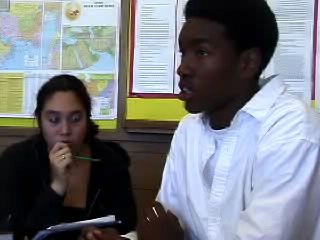 Clip
4: Jerryck sees the passage as a metaphor. “You can take that
as two ways”—here for me is a perfect example of reading as
a social, cultural act as well as a cognitive act. Jerryck is bringing
the piece an understanding that the other kids didn’t have or at
least didn’t mention but they pick up on it. Then Isabel brings
in what she knows about boxing which invites
Clip
4: Jerryck sees the passage as a metaphor. “You can take that
as two ways”—here for me is a perfect example of reading as
a social, cultural act as well as a cognitive act. Jerryck is bringing
the piece an understanding that the other kids didn’t have or at
least didn’t mention but they pick up on it. Then Isabel brings
in what she knows about boxing which invites
Jerryck to tell what he knows about boxing. (During this discussion, there
I am moving a chair to sit down with a group. That’s important to
me—I will sit in with groups to listen but only after the groups
are going. The kids need to take responsibility for getting the groups
working.)
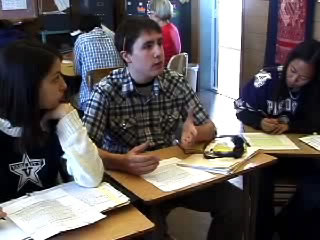 Clip
5:
Notice Christine always draws the group back to the prompt. “diction”—“Proud
club fighter.” The discussion is so good: they’re taking turns,
acknowledging each other, using each others' ideas, defending their ideas,
deepening their understanding. They ask each other questions and respond.
See Petya’s question that Jerryck answers. They listen intently
to each other and are doing serious stylistic analysis.
Clip
5:
Notice Christine always draws the group back to the prompt. “diction”—“Proud
club fighter.” The discussion is so good: they’re taking turns,
acknowledging each other, using each others' ideas, defending their ideas,
deepening their understanding. They ask each other questions and respond.
See Petya’s question that Jerryck answers. They listen intently
to each other and are doing serious stylistic analysis.
[About this
group: really mixed in terms of major identity in the senior class: Jerryck
is a basketball player (heavily recruited by big schools) and transfer
student—new to EC this year, Ryan is a debater, Christine is senior
class president, Isabel is a techie/Gay Straight Alliance member, Petya
is an immigrant from Bulgaria, Josh is into leadership and drama productions,
Marcelle—shy member of the popular crowd. None of these kids are
close friends outside of class though they are in classes together.]
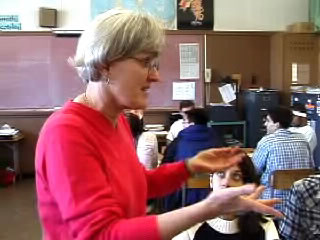 Clip
6: I enter in. Here I couldn’t resist—I’m reacting
to Jerryck’s point about Michael Jordan. Then after I have added my
2 cents, I have a teaching moment. I ask them to use the SOAPS technique
to push themselves about the SO WHAT of the piece—what else is this
about besides the death of Paret? But notice—I go in for just a moment
and leave. I don’t want to overwhelm them. Then, again Jerryck brings
in what he knows about boxing (social/cultural stuff) and so does Ryan.
Christine focuses the group again on the task. Petya clarifies what the
Occasion is in SOAPS. Jerryck goes back to summarize the text, off the SOAPS
business. Petya tries to steer the conversation back to the SOAPS by talking
about the narrator. Josh talks a bit about the narrator but goes into the
narrative again and off the SOAPS. Christine goes back to the prompt, to
focus the group. [They work the whole time. They do not get the point that
the boxer actually died.]
Clip
6: I enter in. Here I couldn’t resist—I’m reacting
to Jerryck’s point about Michael Jordan. Then after I have added my
2 cents, I have a teaching moment. I ask them to use the SOAPS technique
to push themselves about the SO WHAT of the piece—what else is this
about besides the death of Paret? But notice—I go in for just a moment
and leave. I don’t want to overwhelm them. Then, again Jerryck brings
in what he knows about boxing (social/cultural stuff) and so does Ryan.
Christine focuses the group again on the task. Petya clarifies what the
Occasion is in SOAPS. Jerryck goes back to summarize the text, off the SOAPS
business. Petya tries to steer the conversation back to the SOAPS by talking
about the narrator. Josh talks a bit about the narrator but goes into the
narrative again and off the SOAPS. Christine goes back to the prompt, to
focus the group. [They work the whole time. They do not get the point that
the boxer actually died.]